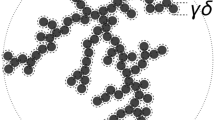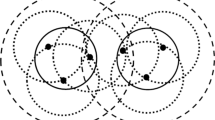Abstract
Classical site percolation is studied on square pore networks generated through the dual site–bond model (DSBM). This model allows different strengths of correlations among the lattice elements in such a way that patches of sites and bonds with similar sizes are structured as correlations are setup. The typical size of these patches depends on the strength of correlations. The aim of this paper is to find whether the global patchy structure is responsible for the patterns found in classical percolation structures. To this end, we measure different static quantities of the correlated networks, such as correlation length, and fractal quantities of the spanning clusters. We observe a significant gap from the reported behavior. For instance, our results indicate that the fractal dimension of the spanning cluster is nonuniversal and changes with the network correlation. The DSBM is good to produce classical percolation clusters with different fractal dimension and different lacunarity behavior. Comparison with other authors’ recent findings is presented.








Similar content being viewed by others
Abbreviations
- \(a\) :
-
Slope of lacunarity behavior
- \(b\) :
-
Intercept of lacunarity behavior
- \(d_\mathrm{f}\) :
-
Fractal dimension
- DSBM:
-
Dual site–bond model
- \(F_\mathrm{B}(R_\mathrm{B})\) :
-
Probability density functions by bonds
- \(F_\mathrm{S}(R_\mathrm{S})\) :
-
Probability density functions by sites
- \(L(r)\) :
-
Feature lacunarity \(L\) for a box size \(r\)
- l.u.:
-
A linking unit
- \(m\) :
-
Number of pixels
- \(M\) :
-
Number of sites
- \(n\) :
-
Integer
- \(N(r)\) :
-
Number of boxes \(N\) of size \(r\)
- \(P\) :
-
Probability
- \(R\) :
-
Represent the “metric”
- REV:
-
Representative elementary volume
- \(s_{i}\) :
-
Threshold
- \({\mathbb {Z}}\) :
-
Integers
- \(\mu \) :
-
Mean value of sites distribution
- \(\xi \) :
-
Correlation length
- \(\rho \) :
-
Percolation threshold
- \(\rho _\mathrm{C}\) :
-
Fraction occupied by the spanning cluster
- \(\Omega \) :
-
Overlap between distribution functions site–bond
References
Al-Kadi, O.S., Watson, D.: Texture analysis of aggressive and nonaggressive lung tumor CE CT images. IEEE Trans. Biomed. Eng. 55(7), 1822–1830 (2008)
Allain, C., Cloitre, M.: Characterizing the lacunarity of random and deterministic fractal sets. Phys. Rev. A 44, 3552–3558 (1991)
Barros Filho, M.N., Sobreira, F.J.A.: Accuracy of Lacunarity Algorithms in Texture Classification of High Spatial Resolution Images from Urban Areas. In: XXI ISPR Congress, Commission III, XXXVII-B3b, pp. 417–422. The International Archives of the Photogrammetry, Remote Sensing and Spatial Information Sciences, Beijing, China (2008)
Ben-Avraham, D., Havlin, S.: Diffusion and Reactions in Fractals and Disordered Systems. Cambridge University Press, Cambridge (2004)
Bondy, J.A., Murty, U.S.R.: Graph Theory with Applications. North-Holland, New York (1982)
Bonny, J.D., Leuenberger, H.: Matrix type controlled release systems: percolation effects in non-swellable matrices. Pharm. Acta Helv. 66, 160–164 (1991)
Cordero, S., Kornhauser, I., Domínguez, A., Felipe, C., Esparza, J.M., Rojas, F., López, R.H., Vidales, A.M., Riccardo, J.L., Zgrablich, G.: Site-bond network modeling of disordered porous media. Part. Part. Syst. Charact. 21, 101–116 (2004)
Cruz, O., Hidalgo, R., Alas, S., Cordero, S., Meraz, L., López, R., Domínguez, A.: Is the Alexander-Orbach conjecture suitable for diffusion in correlated percolation clusters. Adsorpt. Sci. Technol. 29(7), 663–676 (2011)
De Gennes, P.G.: Reptation of a polymer chain in the presence of fixed obstacles. J. Chem. Phys. 55(2), 572–579 (1971)
Dong, P.: Test of a new lacunarity estimation method for image texture analysis. Int. J. Remote Sens. 21(17), 3369–3373 (2000)
Dominguez, A., Bories, S., Prat, M.: Gas cluster growth by solute diffusion in porous media: experiments and automaton simulation on pore network. Int. J. Multiphase Flow 26, 1951–1979 (2000)
Felipe, C., López, R.H., Domínguez, A.: 2D automaton simulation of bubble growth by solute diffusion in correlated porous media. Adsorption 11, 491–496 (2005)
Gorsich, D.J., Tolle, C.R., Karlsen, R.E., Gerhart, G.R.: Wavelet and fractal analysis of ground-vehicle images. Wavelet Appl. Signal Image Process. IV 2825, 109 (1996)
López, R.H., Vidales, A.M., Domínguez, A., Zgrablich, G.: How does a patchy network affect the structure of invading patterns. J. Colloids Surf. A Physiochem. Eng. Asp. 300, 122–128 (2007)
López, R.H., Vidales, A.M., Zgrablich, G.: Correlated site bond ensembles statistical equilibrium and finite size effects. Langmuir 16, 3441–3445 (2000)
Luo, L., Lin, H.: Lacunarity and fractal analyses of soil macropores and preferential transport using micro-X-ray computed tomography. Vadose Zone J. 8, 233–241 (2009)
Mandelbrot, B.B.: The Fractal Geometry of Nature. Freeman, San Francisco (1982)
Mayagoitia, V., Rojas, F., Kornhauser, I., Pérez-Aguilar, H.: Modeling of porous media and surface structure: their true essence as networks. Langmuir 13, 1327–1331 (1997)
Meraz, R.L., Vidales, A.M., Domínguez, A.: A fractal-like kinetics equation to calculate landfill methane production. Fuel 83, 73–80 (2004)
Plotnick, R.E., Gardner, R.H., O’Neill, R.V.: Lacunarity indices as measures of landscape texture. Landsc. Ecol. 8, 201–211 (1993)
Riccardo, J.L., Pereyra, V., Zgrablich, G., Rojas, F., Mayagoitia, V., Kornhauser, I.: Characterization of energetic surface heterogeneity by a dual site-bond model. Langmuir 9, 2730–2736 (1993)
Rothschild, W.G.: Fractals in Chemistry. Wiley, New York (1998)
Sahimi, M.: Flow and Transport in Porous Media and Fractured Rock. VCH, New York (1995)
Sener, B.: Lacunarity analysis of TEM images. In: Sener, B. (ed.) Innovations in Chemical Biology. Springer, Berlin (2008)
Stevens, N.E., Harro, D.R., Hicklin, A.: Practical quantitative lithic use-wear analysis using multiple classifiers. J. Archaeol. Sci. 37(10), 2671–2678 (2010)
Tolle, C.R., McJunkin, T.R., Rohrbaugh, D.T., LaViolette, R.A.: Lacunarity definition for ramified data sets based on optimal cover. Physica D 179(3–4), 129–152 (2003)
Valous, N.A., Sun, D.W., Allen, P., Mendoza, F.: The use of lacunarity for visual texture characterization of pre-sliced cooked pork ham surface intensities. Food Res. Int. 43(1), 387–395 (2010)
Vannucchi, P., Leoni, L.: Structural characterization of the Costa Rica decollement: evidence for seismically-induced fluid pulsing. J. Earth Planet. Sci. Lett. 262(3–4), 413–428 (2007)
Yaşar, F., Akgünlü, F.: Fractal dimension and lacunarity analysis of dental radiographs. Dentomaxillofac. Radiol. 34(5), 261–267 (2005)
Acknowledgments
The authors wish to thank the Ministry of Education of Mexico (SEP-PROMEP) for the support awarded to the Academic Network “Diseño nanoscópico y textural de materiales avanzados”. Thanks are also due to the National Science and Technology Council of Mexico (CONACyT) for the economic support awarded under Project “Apoyo para el desarrollo del programa de fortalecimiento académico del posgrado de alta calidad, COFON 914009.” The use of computer facilities of Laboratorio de Supercómputo y Visualización en Paralelo (Cluster Aitzaloa) of UAM-Iztapalapa is gratefully acknowledged.
Author information
Authors and Affiliations
Corresponding author
Rights and permissions
About this article
Cite this article
Hidalgo-Olguín, D.R., Cruz-Vázquez, R.O., Alas-Guardado, S.J. et al. Lacunarity of Classical Site Percolation Spanning Clusters Built on Correlated Square Lattices. Transp Porous Med 107, 717–729 (2015). https://doi.org/10.1007/s11242-015-0463-3
Received:
Accepted:
Published:
Issue Date:
DOI: https://doi.org/10.1007/s11242-015-0463-3




